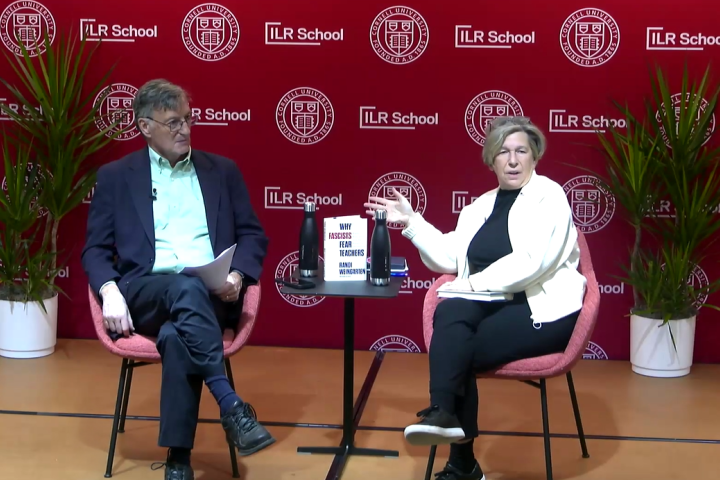
UAW Faces Critical Inflection Point
By Suraj Parikh ‘25 | Editor, Scheinman Institute Newsletter and Blog
Nearly 90 years after its founding, the United Auto Workers face a critical inflection point that will certainly have massive implications for the union’s future. As the UAW gears up for another contract fight with the Big Three American automakers, the union will have to account for changes in the auto industry and economy as a whole if they want to survive and keep their bargaining power going forward.
The UAW is one of the most impactful labor organizations in American history – since its founding, UAW tactics and contracts have brought many innovations to American labor relations and set our nation’s societal standard for a “middle-class life”. The previous national UAW contract negotiations, in 2019, included a strike against General Motors. The union has been profoundly affected by a corruption probe that sent top officials to prison while requiring direct elections of national officers for the first time in the union’s history.
The UAW’s contracts with the Big Three – GM, Ford, and Stellantis (formerly Chrysler) – expire in mid-September, with negotiations likely starting in the summer of 2023. Professor Harry Katz, Jack Sheinkman Professor of Collective Bargaining at the ILR School and Director of the Scheinman Institute, said that the UAW’s pattern bargaining strategy generally involves “picking a target company that they have the most leverage over.” Then, after finalizing a contract with that company, the other automakers generally follow suit and sign similar contracts. According to Katz, the UAW chooses its target company based on a “variety of factors”, including company financials, personal relationships between union representatives and management, and other extenuating circumstances a company faces. With the national agreements detailing wages, benefits, and job security concerns, locals at each individual plant will negotiate more specific plant-level agreements.
This year’s contract negotiations will almost certainly address the regular provisions in the auto industry’s contract fights: wages, benefits, plant closure prevention, profit sharing, and retirement benefits. However, the implications of the transition to electric vehicles will be a critical contentious issue in any new contract. Katz points out that EVs, which are set to be the only option for new car purchases as soon as 2030 in some states, “require less labor to produce” than internal combustion engine cars. This means that as the Big Three inevitably transition to EVs, the UAW will face job cuts and a potential “membership crisis”. A top priority for the UAW is likely to be the unionization of new EV plants and more robust benefits for workers that are laid off in the EV transition.
As the auto manufacturers increasingly go electric, the UAW’s longstanding problem of a growing role for non-union suppliers will be exacerbated. Katz says that a major issue for the UAW already is that the Big Three have outsourced a sizeable share of the car component manufacturing to external and often non-union suppliers. With electric vehicles, the external supplier issue will become critical with regard to two components: batteries and semiconductors. Some EV battery plants are partnerships between Big Three automakers and battery companies – the UAW has already been successful in unionizing a few Ford and GM battery plants that are in partnership with South Korea’s LG. However, as other battery manufacturers like Samsung, Panasonic, and Tesla build out their manufacturing capacity, the UAW may try to take steps to ensure that the Big Three only buy from union battery plants – especially considering their consistent inability to unionize the substantial number of assembly plants owned by companies outside of the Big Three now operating in the United States. The UAW would be well-served by trying to unionize US-based semiconductor plants (and possibly requiring Big Three automakers to exclusively buy from those plants), whose number will sharply increase in the coming years thanks to the CHIPS Act recently passed by the federal government.
As the UAW enters their negotiations with the Big Three legacy automakers, an important new dynamic to watch is the impact of the previously mentioned UAW elections. In the first-ever direct election in the union’s history, the more aggressive, anti-establishment Unite All Workers for Democracy (UAWD) slate won a majority of the seats on the union’s board, including the presidency. The victory of the UAWD over the Administration Caucus, which has run the UAW for several decades, will almost certainly lead the union to adopt a more militant direction. Katz notes that newly elected UAW President Shawn Fain ran on “being tougher in contract negotiations”, and his recent win gives him a mandate to push the Big Three more aggressively and thus “increase the likelihood of a strike.”
Although the democratization of the UAW and their newly-militant leadership certainly gives the rank-and-file more representation, the union’s membership seems to have become demoralized. Only 12% of eligible voters participated in the 2022 leadership election (and 14% participated in the run-off election for the position of UAW president), figures which Katz says are a “sad indictment of the union.” He points out that most workers knew that the election was happening, but a “lack of connectedness” between workers and the UAW national leadership hindered turnout. The new UAW leadership will likely try to re-energize the rank-and-file through a variety of tactics: unionizing new facilities, conducting more worker outreach, and utilizing worker power through strikes to achieve material gains although it remains to be seen whether those or other mobilization efforts will succeed.
Another challenge facing the UAW is that the Big Three’s share of car production has been declining for decades due to the combination of growing imports and the sizeable production on US soil of so-called “transplants” (assembly plants owned by foreign-based auto companies). The new UAW leadership might bring new organizing or perhaps other unions will enter the fray. An interesting recent development is that Workers United, the SEIU-affiliated powerhouse behind Starbucks’ union campaign, recently announced it is trying to unionize Tesla’s Buffalo Gigafactory. The UAW’s future may also increasingly lie outside the auto industry entirely: America’s largest strike last year was at the University of California, where 48,000 UAW academic workers went on a six-week strike and won significant gains in wages and benefits. Here in Ithaca, the UAW represents Cornell Dining workers and TCAT (public transportation) employees – yet other examples of the diverse array of sectors represented by the autoworkers’ union.
Wages, benefits, job security, and the other traditional contract provisions are as relevant as ever in this year’s contract fight between the UAW and the Big Three. The union’s new leadership has a mandate to use their power to get a better deal for workers. But, the auto industry’s shift to EVs and the large non-union auto assembly and parts sectors will exert heavy influence on the negotiations and weaken the union’s leverage. The UAW faces a critical challenge in finding ways to adapt to the electric revolution, re-energize the rank-and-file, and expand the representation.



